Dwarf Umbrella Tree: The Houseplant You Were Looking For
Author: Jen Worst | Editor: Omar Alonso
Review & Research: Jen Worst & Chris Miller
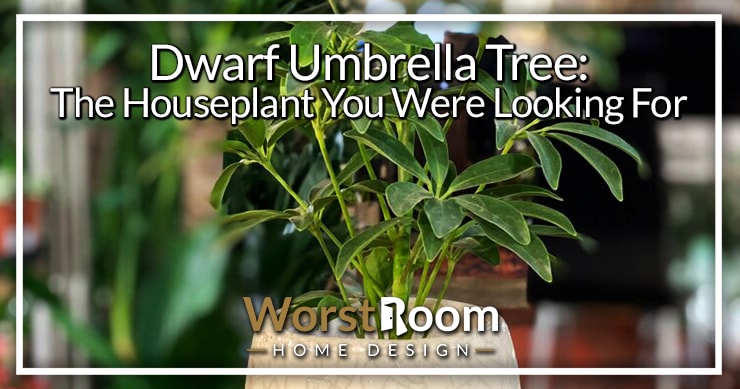
The dwarf umbrella tree is one of the many species of the Schefflera plant. This dwarf variation, as the name suggests, is a small plant that can be a very easy houseplant to take care of.
This is only one of the reasons the dwarf umbrella tree has become an increasingly popular houseplant, especially for amateur gardeners.
This plant has leaves that grow in bundles of five or nine; the leaves are oval with pointed tips, and the cluster of leaves turn downwards, so each bundle looks like an umbrella. The dwarf umbrella tree does not need an extremely attentive owner.
With the right growing conditions and occasional grooming, this plant is one of the most natural plants to take care of. Let's learn more about it so you can make your decision.
Dwarf Umbrella Tree Names & Misconceptions
The dwarf umbrella tree’s official name is Schefflera araboricola. However, for ordinary people, this plant is also called “octopus tree” and “parasol plant.” Although these names don't sound similar, they're all intended to refer to the same plant.
The umbrella tree is often confused with other plants. It's easy to mistake the dwarf umbrella tree for a Heptapleurum. This is because these plants are very similar, both botanically and physically.
The only advantage of such similarities is that both have to be taken care of the same way. As a result, no significant consequences can arise from the swapping of these two plants.
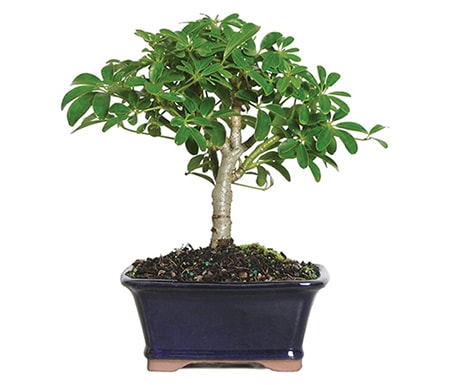
However, another misconception about the dwarf umbrella tree is that it's the same as the Cyperus plant. Swapping these two plants will bear inevitable consequences as they don't look the same, and the Cyperus plant requires a great deal of attention.
While a dwarf umbrella tree is natural to take care of, a Cyperus is not, and so, the mistake of swapping these two plants will be discovered soon enough with undesirable results.
Not Just Leaves But Flowers & Berries, Too
It may not seem like it, but the umbrella tree is capable of producing flowers and berries. Although this is true, the umbrella tree doesn't often bloom when it's placed indoors. However, when it is outside in the summer season, it produces pinkish-red spike-like flowers.
These flowers make room for berries, which change color as they mature. Their color ranges from yellow when the berries have just started blooming, to red, and finally black in their finished state.
Types of Dwarf Umbrella Trees
This popular plant comes in two types, with the core difference being the colors displayed on the leaves, whether we're talking about bonsai, dwarf, small, or even full grown tree sizes.
Lush Green
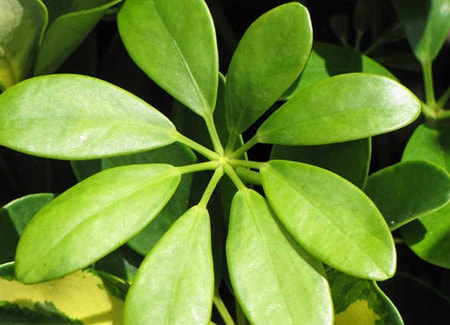
This variety has glossy and dark green leaves. The leaves are plain and grow in thick clusters of often more than nine leaves. The vibrant green range can bravely resist changes in growing conditions. It will thrive just as well in slightly colder temperatures and dim light.
Variegated
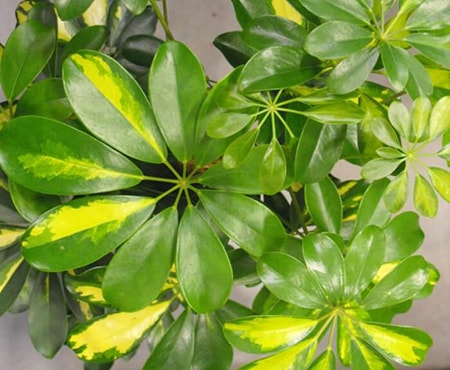
The variegated variety of dwarf umbrella tree has a big yellow or badge patch in the center of each leaf. This variety is rather delicate, and will quickly wither in dim light. Although both types are well-liked by customers, it is the variegated variety that is often found to be in higher demand.
Is The Dwarf Umbrella Tree Safe?
It's essential to be aware of any health concerns before purchasing any plant. The dwarf umbrella tree, in most cases, does not affect its owners. However, this does'nt mean that it's not toxic.
The dwarf umbrella tree is considered mildly toxic. As a result, it's recommended for owners to keep their other pets such as cats and dogs away from this plant as much as possible, especially if they're prone to eating the leaves of plants.
In some cases, the this tree can cause allergic reactions due to its sap. Eating the leaf, flower, or berry of the dwarf umbrella tree is strictly advised against.
If any part of the plant is consumed, the affected individual may experience disoriented movements, a tingling sensation in the mouth, and naturally, regurgitation. In any of these extreme cases, a doctor’s visit is necessary.
Watch Out For Pests on Your Dwarf Umbrella Plant
One nuisance associated with the dwarf umbrella tree is the presence of spider mites. You may be wondering where do spider mites come from since they seem to appear out of nowhere.
These little creatures spin their webs on the underside of the leaves. However, spider mites can be easily tackled. Their webs should be removed from the leaves by dusting them from time to time.
Spraying the plant with water is also very effective as these spider mites cannot stand humidity. So, if the plant is placed outside where there is plenty of sunlight, and the leaves are sprayed with water two or three times a day, the mites don't stand a chance at survival. Neem oil works especially well.
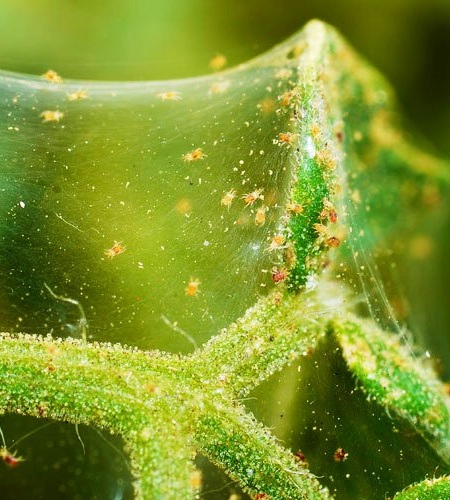
You can also couple these umbrella trees with plants that repel spiders indoors or even combine your water spray with a natural spider repellent. Please note that these are mites and not classified as spiders, but these solutions do work for mites as well as other insects.
Dwarf Umbrella Tree Care
Taking care of your small umbrella tree is easy and also a must if you intend to keep it around for long enough to enjoy its presence. Work these care methods into your daily schedule and you'll have no problems.
Water
The only thing more important than watering the dwarf umbrella tree is knowing how to do it properly. The dwarf umbrella plant doesn't need to be watered often.
It can withstand small drought periods like a good sport. However, the plant shouldn't be deprived of all water content, in which case the leaves will shrink, and the plant will wilt.
However, on the other end, the small umbrella tree can quickly rot if it's overwatered. The stem and the roots rot speedily, and the leaves turn black and fall off.
The dwarf umbrella plant has to be watered with lukewarm water and in moderate amounts. The plant should only be irrigated when the soil has completely dried out, and the foliage has begun to wilt.
However, care should be taken to drain the soil soon after it is irrigated to prevent it from staying wet for long. Moist soil can cause the plant to rot.
Nevertheless, the small umbrella tree enjoys humidity. Therefore, it's recommended to spray the leaves once every two or three days, so the plant remains hydrated. It's better to use lukewarm and clean water, so no residues are left behind on the foliage later on.
Sunlight
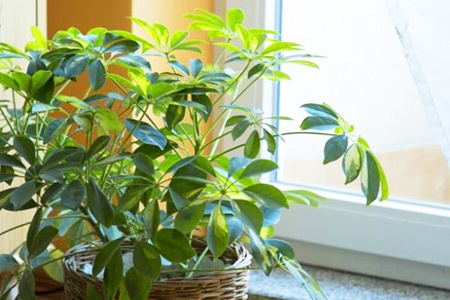
The dwarf umbrella tree should be placed a few inches away from the window and in the path of regular sunlight as this plant does require plenty of sunlight for proper growth.
The plant should not be placed under direct sunlight for more than a few hours every day, as excessive heat can cause the leaves to burn. On the flip side, a lack of light will cause the plants to become yellow and droop.
The ideal middle ground here is to place the plant in indirect but bright sunlight. However, if you gravitate towards a smaller plant with little to no propagation, placing the plant in a dimly lit corner of the house will get the job done just fine.
Soil
The dwarf umbrella tree is not very selective when it comes to soil. Any soil can be used as long as it can retain sufficient moisture and drain quickly. This means the soil of any potted plant should work just fine.
Usually, gardeners make their soil or aerate the potted plant's soil with perlite, vermiculite, or rough sand.
Fertilizers can be added to enrich the soil, but the amount of fertilizer added depends on the growing season. In summers, adding fertilizers can boost the umbrella tree's growth and lead to luscious and thick plants.
In the winter season, the maintenance level is low. Fertilizing the soil once in a few weeks should be enough. We're not talking about changing it out entirely, only freshening it up with new nutrients using the right fertilizer numbers.
Grooming
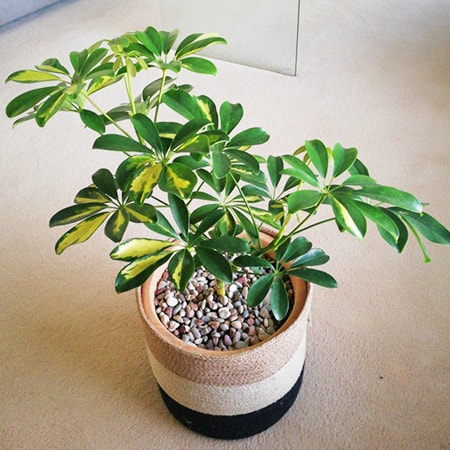
It becomes necessary to change the plant's pot soil every couple of years. Repotting is non-negotiable, so don't think that it can be ignored.
It's to be noted that new soil comes with an adequate amount of fertilizer, so more fertilizer should be added. When upgrading to a unique pot, the dwarf umbrella tree should be repotted into a sturdier pot. A more robust and bigger pot will ensure that the plant doesn't topple over.
Another grooming tip is to prune the the tree tree when necessary. Cutting a few inches off the leaves will restrict the plant from quickly growing into an unmanageable mess.
The plant propagates speedily and can very immediately begin to resemble a wild, unkempt bush. Therefore, it's better to pinch the tips of the leaves off, so the dwarf umbrella tree remains an amenable houseplant without growing out of control.
The Small Dwarf Umbrella Tree Plant is Great
The dwarf umbrella tree is a popular houseplant. It adds a great lush look and can make any living space appear more vibrant and alive. The plant comes in two varieties, but both of them are equally easy to take care of.
These plants come with specific instructions, mostly regarding how it is meant to be taken care of. However, whether it's the right intensity of sunlight, or an appropriate amount of watering, the maintenance requirements for this plant are easy to follow.
Therefore, this plant is by no means a hassle to take care of. Owners must be careful when watering it and avoid consuming any part of the plant at all costs.
When the basic rules for taking care of a dwarf umbrella tree are followed, this lush houseplant becomes the perfect addition for any garden or plant collection.



